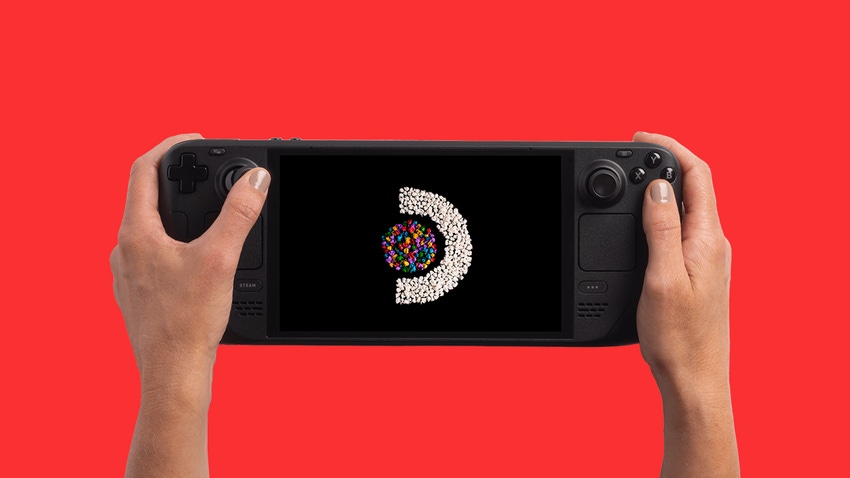
It's close to freezing outside and the rain is battering the window of my apartment. It is the stuff of dreams. I'm nestled in bed with a mug of peppermint tea, my face illuminated by the soft glow of the paper lamp in the corner of my room and the crystalline embers emanating from the remarkable display on Valve's new Steam Deck OLED.
Currently, I'm soaring across a verdant meadow atop an adorable creature in the demo for Flock while a herd of kaleidoscopic floating sausages glide in my wake. The landscape's rich palette of flora and fauna is realized in vivid detail thanks to the HDR OLED screen on the new-and-improved Steam Deck, which Valve said will deliver brighter colors and blacker blacks to showcase your library in a "whole new light."
After spending a few weeks putting the device through its paces, it feels fair to say the company has made good on that promise. Every title I've tested—which includes the likes of Chants of Sennaar, Flock, Lumines, Moonring, Apex Legends, and Street Fighter 6—was a visual feast.
Colors fizz and contrast in striking fashion, belying the fact that you're playing on a handheld machine as opposed to a churning console. Valve has squeezed every drop of potential out of the larger 7.4" OLED display, which offers slightly more retail estate than the 7" LCD display slapped on the original Steam Deck—and that's good news for everyone.
For developers investing time and resources in Steam Deck support, the introduction of the OLED model feels like a notable step up—enabling compatible 'Deck Verified' titles to really showcase their wares to a growing audience of millions that, like this Steam Deck owner, might not actually own a traditional gaming PC.
What's in a screen?
As for consumers, it feels like the Steam Deck OLED is being positioned as the 'definitive' version of Valve's handheld for the here and now, with the company recently confirming that a generational upgrade is "years away." Both the OLED and LCD model boast similar tech specs—meaning existing owners might not feel the need to upgrade immediately—but there are some key differences.
Obviously, there's the screen. I've already mentioned it, but given it's the selling point we're going to discuss it some more. As well as being larger than its LCD forebear, the OLED display supports up to 90Hz refresh rate (compared to 60Hz offered by the original Steam Deck) and can deliver a maximum brightness of 1,000 nits (HDR) or 600 nits (SDR). According to Valve, the original model was only capable of reaching 400 nits typical.
The OLED display also boasts a >1,000,000 : 1 contrast ratio and improved touch screen functionality that Valve has branded "high performance touch." It's hard to gauge how impactful the latter tweak is, but the screen was indeed receptive when probed by my waggling digits.

Image via Valve
There are other improvements, too. Valve reckons Steam Deck OLED will deliver 30-50 percent more playtime thanks to a combination of a larger battery and the display itself requiring less power. An updated AMD APU also helps out in that regard and purportedly delivers "better efficiency" overall. I personally only had to hastily rush to charge the Deck on one occasion after playing Apex Legends—an intensive multiplayer shooter—for well over two hours, so that tidbit seems to ring true.
A dedicated bluetooth antenna has been added to improve connectivity when linking peripherals and controllers, and Wifi 6E provides downloads with a shot in the arm thanks to increased bandwidth and lower latency. Valve says software will download up to three times faster on the OLED, which is a marked improvement.

For those who plan on spending a lot of time with their Steam Deck in handheld mode (remember, you can connect it to larger displays using the official dock or any old HDMI cable), you'll be pleased to hear the OLED model is 5 percent lighter and runs cooler thanks to a upsized fan. Sorry, fume huffers.
Although Valve has trimmed some fat, the Steam Deck OLED is still rather bulky when compared with other handhelds. For example, Valve's device weighs around 640 grams—making it significantly heavier than the Switch OLED, which weighs approximately 420 grams with both Joy-Cons attached.
Still, it never feels that heavy in practice, and the biggest gripe I had when it came to usability was the awkward placement of buttons the D-pad and A X Y B inputs that can leave your hands feeling rather stretched after longer sessions. Your milage will likely vary here, but there's no denying the Steam Deck is a bona fide Wide Boy.
The impossible made real
In our review of the original Steam Deck, former Game Developer publisher Kris Graft described the console as "one of the most interesting, borderline magical, pieces of game hardware available today" and the Steam Deck OLED is cut from the same mystical cloth.
Speaking as somebody who was an avid PC gamer in their teens before ultimately choosing to prioritize the convenience and (relative) affordability offered by consoles, the Steam Deck OLED feels tailor made for me. The device offers a chance to reconnect with a platform that can often feel daunting by building an on-ramp around approachable, console-friendly design sensibilities that now, thanks to the inclusion of that stunning OLED display, allows the vast, perpetually expanding Steam library to truly shine.
I imagine those who've spent years investing in Steam as a platform have already secured their upgrade, but for anybody wondering if the Steam Deck OLED represents the perfect time to buy into the handheld PC ecosystem Valve is creating, the answer is an unreserved 'yes.'
The retooled console is an outstanding piece of hardware that exists at the burgeoning intersection of handheld and console platforms. It can feel impossible at times—and yet it's right there. In the palm of your hands.
Read more about:
Top StoriesAbout the Author(s)
You May Also Like













